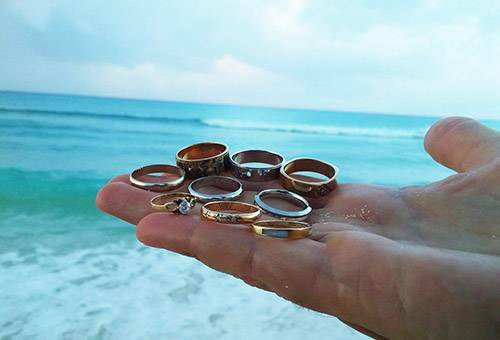Contents:
- magnet
- temperature
- type, sound and smell
- hand reagents
- handstrap Internet or numeric directories
- Hydrostatic weighing
- Chemical test
Want to determine what exactly this cute owner of the antiques store is trying to sell to you,you were presented with a new silver chain, in which quality do you doubt? Thinking about how to check silver at home? No, we will not suggest that you bring a product to a laboratory for spectral analysis. Instead, let's try to limit ourselves to all available means, which, most likely, will be at hand and you.

Magnet
The simplest tool that can detect a fake is a magnet. If the product has been magnetized, it means that it is definitely made not from noble metal, what the negligent seller tries to convince you. Silver, like gold, does not have a reaction to the magnet, but unfortunately, under the reverse scenario one can not be 100% sure that you have the purest silver, so this method is more suitable to dispel an outright forgery, and its betteruse in combination with the tips below.

Temperature
Taking a silver spoon in your hand, you will feel that the product has quickly acquired the temperature of your body. This is due to the high thermal conductivity of silver, which gives suspiciously long cool counterfeits of other metals.
Board
You can also go from the reverse and put, for example, on a coin or an ice cube tray. If it melts abnormally quickly, then you have real silver, if not, it's better to refrain from buying.

Kind, sound and smell
Not everyone can learn the silver by these criteria, and it's also difficult to call this method exact. But if you had silverware, say, in childhood, then, most likely, remember this specific smell. Real silverware has a thin and sonorous sound, somewhat reminiscent of crystal, and if you throw a coin on a metal tray, it completely "singing" in a very special way. Also, in the color of new or well-groomed silver there are no admixtures of shades of yellow or pink, although they may appear if the metal is not taken care of properly.

Reaction of silver to iodine
hand reagents If you do not have the desire to listen, sniff and look at you, then the authenticity of silver can be determined with bleach, sulfuric acid or iodine. To do this, put a small spot on the product with a cotton bud and watch its reaction. The product began to darken around the perimeter of the spot? Then before you is a silver or at least a silvered thing. No? Then there is no smell of silver here.
advice And you can also check the authenticity without fear of messing up by chopping it. In this case, when contacting silver with black, chalk should be chalked.

A trace on the hands of
In the authenticity of the product it is worth doubting if, after a long hold in the hands, it left a mark on them. Pure silver, in which there are no impurities, will not leave any plaque on its hands.
Internet or numeric directories
An excellent way for numismatists is to compare the weight of a coin in a reference book with the actual weight of the product offered for purchase. Because of the difference in density, it is very easy to determine a coin made of other metals, even if it is silvered and in appearance just like a real one.

Scale for hydrostatic weighing
1 - mesh( perforated) glass;2 - a vessel with a drain for water;3 - a cup with a shot to balance the weight of the mesh glass in water;4 - weights
Hydrostatic weighing
The easiest way to determine the authenticity of a product is by determining the density of the material. To do this, you must first weigh the dry coin. Then pour in a glass of water, reset the scale and determine the "wet" weight of the coin. Now we divide the "dry" weight by the difference in two dimensions, and if the number obtained is in the region of 10.5, then you have real silver, since there is no similar density for metals used for counterfeiting.
At home you can try to use a food electronic scales, but to determine the authenticity of a coin or jewelry, their accuracy should be quite high.

Chemical test
If you are not strangers to chemistry, get a chemical test for the authenticity of silver. This is one of the most accurate ways to determine the quality of a silver-plated product substrate. For the test, you need either to do a pretty deep scratch on the inconspicuous part of the product, or rub the product against the assay stone. Now on the trail on the stone or substrate in a scratch drip acid and look at the color: the brighter the shade of red, the purer the silver. Thus, a light brown color indicates silver of the 800th test, and the green color is already 500th. The remaining colors will give the most popular for silvering metals: yellow corresponds to tin or lead, dark brown - brass, and blue - nickel. Now you can be sure of the composition of the product not only on the surface, but also inside.
As you can see, it is not necessary to bend or saw a silver spoon to determine the authenticity, even if you did not find the brand with a breakdown. Take advantage of these tips, and you repeatedly reduce the chance to run into a fake.



